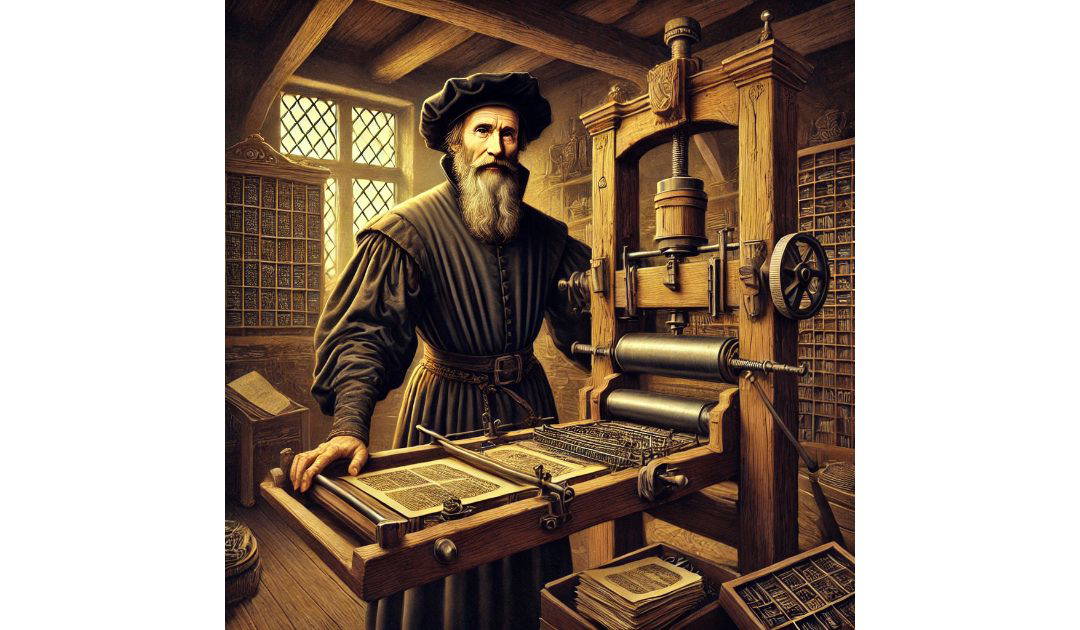The Sir Anthony Standen Adventures would be nothing more than a hand written memoir if it weren’t for Johannes Gutenberg, the inventor of the printing press. I think many of us know of Gutenberg, but what about Johann Fust? Gutenberg is famous for his printing press and the Gutenberg Bible. The relationship between Johann Fust and Johannes Gutenberg was central to the history of the printing press but ended in a dramatic legal conflict. Fust, a wealthy merchant and financier from Mainz, initially saw great potential in Gutenberg’s invention of movable type and agreed to fund the project. Gutenberg had been working on his printing technology since the 1430s and needed financial backing to complete the equipment and print the 42-line Bible, now known as the Gutenberg Bible. In 1450, Fust loaned Gutenberg 800 guilders, a considerable amount, to finance the press’s completion and initial operations.
Despite Fust’s financial support, progress on Gutenberg’s Bible was slow, and by 1452, Gutenberg had exhausted the initial loan. Fust extended a second loan of 800 guilders, but this time he imposed stricter conditions, expecting to see returns from Gutenberg’s output. Although Gutenberg was close to completing the Bible by the mid-1450s, the delays and additional borrowing strained their partnership. Fust became frustrated with Gutenberg’s slow pace and possibly worried about the risk to his investment, as no returns had yet materialized.
By 1455, Fust had lost patience and took legal action against Gutenberg, claiming repayment of both loans, which by then included substantial interest. The case went to court in Mainz, and on the sixth of November the court ruled in Fust’s favor. The court ordered Gutenberg to repay the loans and, when he couldn’t, Fust took control of Gutenberg’s press, including the printing equipment and nearly finished pages of the Bible. This legal transfer marked the end of their partnership and resulted in Fust effectively taking over the press that he had helped finance.
After gaining control of the press, Fust partnered with Peter Schöffer, a skilled printer who had been working under Gutenberg. Fust and Schöffer completed the production of the 42-line Bible, marking it with their names and date, which is why it is sometimes considered the first “colophon in a printed book. They went on to print other significant works, including the “Psalter” in 1457, which was notable for its decorative initials and high-quality typesetting.
The outcome of the legal battle had lasting implications. For Gutenberg, losing his press and equipment was a devastating setback, although he later started another printing operation and continued his work. For Fust, however, the successful production of the Bible and other texts solidified his role in the printing industry. The partnership with Schöffer also demonstrated the commercial viability of the press, leading to broader distribution of printed books across Europe.
In hindsight, the conflict between Fust and Gutenberg illustrates the complex intersection of innovation and business interests. Fust’s financial backing was essential to the development of Gutenberg’s printing press, but his actions after the legal dispute show how early printing was influenced not only by technological innovation but also by the business demands of investment and profit. Despite the dramatic split, both men’s contributions played a key role in the early success of the printing revolution, which would go on to reshape European society.
Fust died around 1466, but his legacy lived on through the work of Schöffer and subsequent generations of printers. His role as both a businessman and a pioneer in the printing revolution underscores the importance of financial and logistical support in technological innovation, even as it raises questions about intellectual property, partnership, and the commercialisation of ideas.

